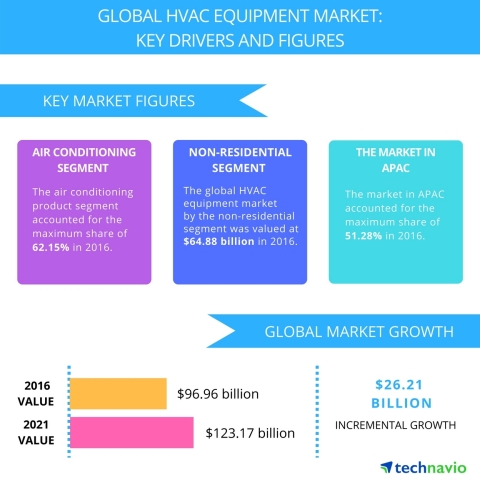LONDON--(BUSINESS WIRE)--Technavio’s latest market research report on the global HVAC equipment market provides an analysis of the most important trends expected to impact the market outlook from 2017-2021. Technavio defines an emerging trend as a factor that has the potential to significantly impact the market and contribute to its growth or decline.
Anju Ajaykumar, a lead analyst from Technavio, specializing in research on engineering tools sector says, “The HVAC equipment market is expected to grow at a significant rate owing to the growing construction industry and increase in income levels in China, India, and other developing countries. The growing non-residential sector in developing and developed countries has further propelled the growth of HVAC systems and increased the consumer base.”
This report is available at a USD 1,000 discount for a limited time only: View market snapshot before purchasing
Buy 1 Technavio report and get the second for 50% off. Buy 2 Technavio reports and get the third for free.
The top three emerging market trends driving the global HVAC equipment market according to Technavio research analysts are:
- Rise in incorporation of building automation systems
- Renewable energy sources for residential heating hinders the gas boiler demand
- Rise in adoption of smartphones for controlling HVAC devices
Looking for more information on this market? Request a free sample report
Technavio’s sample reports are free of charge and contain multiple sections of the report including the market size and forecast, drivers, challenges, trends, and more.
Rise in incorporation of building automation systems
Building automation systems (BAS) are being incorporated in buildings to enhance operations and interact with HVAC, lighting, fire, and security systems in buildings. Due to improvements in sensor technology and availability of better communication technology, BAS technology helps in improved user interface. Manufacturers are applying open protocols, including the Internet protocol, to provide better control solutions.
Energy efficiency ensured by BAS technology allows building owners to improve and enhance facility management with integrated, user-friendly HVAC solutions. By combining these seemingly unconnected technologies, energy savings in buildings can be increased considerably.
Renewable energy sources for residential heating hinders the gas boiler demand
Strict environment regulations will pave the way for the adoption of renewable sources which will lead to a change in the energy mix for residential heating, particularly in Europe. Renewable sources can potentially provide approximately 40% of the energy used for residential heating by 2035. This will reduce residential CO₂ emissions by more than 70% by 2040. The reduction will be in sync with the movement toward achieving the EU 2030 and 2050 climate targets.
The replacement of existing HVAC systems with hybrid systems is relatively easy with minimum building refurbishment. These hybrid systems can also provide large-scale, cost-effective reductions in GHG emissions. The cost benefits offered by hybrid systems in conjunction with the strict environmental regulations will mold the market toward renewable energy sources, thereby significantly impacting HVAC systems.
Rise in adoption of smartphones for controlling HVAC devices
The use of smartphones is gaining importance in the HVAC equipment industry as it enables consumers to connect to technicians easily and get real-time maintenance and support for their systems. Many smartphone providers are developing mobile apps that can control HVAC systems from remote locations. The integration with smart technology is providing new opportunities for HVAC manufacturers. For instance, the integration of smartphones with HVAC systems has resulted in the development of efficient combined cooling and heating devices with web control. One such device is the mini-split manufactured by PowerWise.
“Mini-split users can control temperatures online that appear as part of an energy management dashboard. The newest HVAC systems can connect directly to the Internet, aiding house owners in controlling these systems virtually from a remote location. They can remotely monitor the temperature and humidity levels of their homes using a smartphone or tablet,” says Anju.
Browse Related Reports:
- Global Teleprotection Market 2017-2021
- Global Welding Wires Market 2017-2021
- Global Glass Fiber Foundry Filter Market 2017-2021
About Technavio
Technavio is a leading global technology research and advisory company. The company develops over 2000 pieces of research every year, covering more than 500 technologies across 80 countries. Technavio has about 300 analysts globally who specialize in customized consulting and business research assignments across the latest leading edge technologies.
Technavio analysts employ primary as well as secondary research techniques to ascertain the size and vendor landscape in a range of markets. Analysts obtain information using a combination of bottom-up and top-down approaches, besides using in-house market modeling tools and proprietary databases. They corroborate this data with the data obtained from various market participants and stakeholders across the value chain, including vendors, service providers, distributors, re-sellers, and end-users.
If you are interested in more information, please contact our media team at media@technavio.com.




